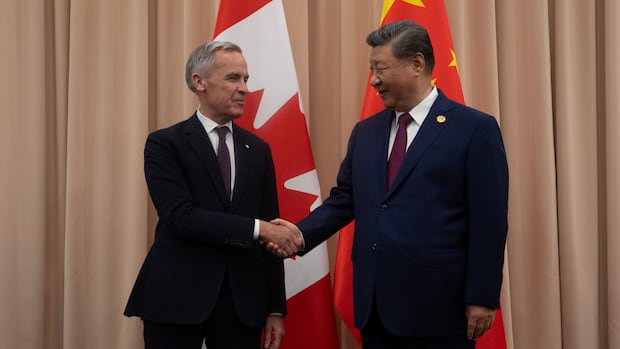Prime Minister Mark Carney is in South Africa for the G20 summit this weekend, a meeting that’s tellingly being boycotted by the world’s largest economy. It’s the latest in a series of moves by U.S. President Donald Trump indicating the world order is rapidly shifting. But as Canada starts to diversify its ties with other countries amidst an increasingly unpredictable and unreliable relationship with the U.S., its pivot toward China, in particular, will need to be strategic — the work must be done while balancing the risks and strengthening the country internally.Carney has already started laying the groundwork, as seen in his meeting last month with Chinse President Xi Jinping on the sidelines of the Asia-Pacific Economic Cooperation summit in South Korea, calling it “long overdue” and a “turning point in the relationship.” However, being late to the table with China doesn’t necessarily mean all opportunity is lost. In fact, as Carney sets an ambitious goal to double Canada’s non-U.S. exports in the next decade, there are gains to be made.Diversifying, increasing tradeIndeed, there is room for growth. While China is Canada’s second-largest trading partner after the U.S., with Canadian exports there estimated at $30 billion in 2024, it still only represents about five per cent of Canada’s total exports. Compare that with roughly 75 per cent of our exports heading south of the border.WATCH | Carney calls Xi meeting in October a ‘turning point’:Carney calls Xi meeting a ‘turning point’ for Canada and ChinaPrime Minister Mark Carney has committed to tackling ‘irritants’ with Chinese President XI Jinping as the two countries had their first formal leader-to-leader contact since 2017. Carney was also invited by Xi for a state visit.Some analysts say a first step in diversifying and increasing trade with China is ending the trade war between the two countries. That would include Canada removing its 100 per cent tariff on Chinese electric vehicles — something the federal government is now reviewing. Currently, China has levied counter-tariffs on Canadian canola, seafood and pork. The Canada China Business Council (CCBC) estimates the impact to be in the billions. For months, industry voices and experts have said this trade war made less sense as U.S.-Canada relations soured.Trade deal or no trade deal, China still holds crucial mineals leverage over U.S.”If it was so easy for our canola farmers to pivot to other markets, we would have done it,” said Greg Chin, associate professor of political science at York University in Toronto. He says there are other opportunities to expand trade, especially for natural resources and agricultural products, including lumber, pork and beef. Manufacturing, research and development opportunitiesStrengthening ties isn’t just limited to the trade in goods, but can be expanded in the research and development, manufacturing and service sectors. This is especially key as China has become a leading technology power.For Canada to catch up, some argue it is better to work with China instead of trying to compete in vain.”We have to look to our own interests,” said Colin Robertson, former Canadian diplomat and vice-president and fellow at the Canadian Global Affairs Institute.Robertson advocates for possible partnerships in electric vehicle battery production and electric vehicles, should Canada decide to drop those 100 per cent tariffs on Chinese EVs. While some politicians, such as Ontario Premier Doug Ford, are advocating for Chinese vehicles to be kept out of the Canadian market to protect the province’s auto sector, Robertson says looking to partners like China might be the only way to save it in the wake of the U.S. decoupling. As Canada focuses on nation-building to reinforce its economy in the wake of Trump’s tariffs, such as streamlining major projects including in the mining sector, there are opportunities to collaborate in research and development, especially since China has a near-monopoly on critical mineral mining and processing.WATCH | How China won the rare earth race:How China won the rare earth race against the U.S. | About ThatChina controls the world’s largest reserves of rare earth elements, and now it’s tightening its grip. Andrew Chang unpacks how China’s export restrictions are giving it powerful leverage over the United States, and why U.S. President Donald Trump is determined to catch up. Images provided by Getty Images, The Canadian Press and Reuters.In its fourth plenum, the Communist party outlined its latest five-year plan, continuing to focus on China’s green transition. Meanwhile, the Canadian Climate Council foresees Canada failing to meet its 2030 emissions target, so there could be opportunities to capitalize on Chinese know-how as well as cheaper and cleaner energy sources. The party is also focusing on speeding up its self-reliance in technology, including artificial intelligence. For Chin, collaborating with China on AI is a no-brainer.”I would hope that Canada can work creatively in this area,” he said, pointing to governance of the use of AI — helping to establish a framework of policies and rules for its use. Soft powerArguably one of the most obvious ways to shore up new friends and partnerships is through the use of soft power, something the two countries have done in the not-so-distant past. At one point, Chinese students made up the highest proportion of international students in Canada. The CCBC says that can happen again. “Canada’s economy is deeply complementary with China’s,” said Bijan Ahmadhi, the council’s executive director, in an email.”[This] creates natural openings across a wide range of sectors, [including] education.” Canada’s tourism sector has also taken a hit in recent years, since tech giant Huawei’s chief financial officer Meng Wanzhou was arrested in Vancouver on a U.S. extradition warrant in 2018. When China loosened group travel restrictions imposed during the COVID-19 pandemic in 2023, Canada was left off the approved list. That is changing, though. Recently, the government decided to allow group tours to Canada again, which was celebrated by many in the tourism industry. “[Chinese tourists] typically stay longer and spend more because there’s such a significant difference in making that commitment to travel all the way here,” said Royce Chwin, president of Destination Vancouver. Soft power can also happen overseas in the form of aid to countries in the Indo-Pacific. Canada could step up in the vacuum caused by Trump shuttering the U.S. Agency for International Development (USAID), says Lynette Ong, distinguished professor of Chinese politics at the University of Toronto. “Aid is a very good way to buy soft power,” she said. “I would double down, even triple down on that.”You need to convince them that you’re on their side.” ‘Eyes wide open’In all of the work Canada does in the coming months and years, analysts say there is a way to balance the risks. “We go in conscious that their system is fundamentally different than our system,” said Robertson, who acknowledges there is still concern, including about human rights issues and cyber interference.That, however, would all be part of the considerations lawmakers must keep in mind as they craft a new China strategy. “China itself would demand that from us,” said Roberston.
3 ways Canada and China can reset their relations in Trump’s new trade world












